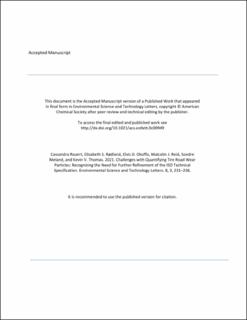| dc.contributor.author | Rauert, Cassandra | |
| dc.contributor.author | Rødland, Elisabeth S | |
| dc.contributor.author | Okoffo, Elvis D. | |
| dc.contributor.author | Reid, Malcolm J | |
| dc.contributor.author | Meland, Sondre | |
| dc.contributor.author | Thomas, Kevin V | |
| dc.date.accessioned | 2021-07-14T06:44:59Z | |
| dc.date.available | 2021-07-14T06:44:59Z | |
| dc.date.created | 2021-03-10T16:23:26Z | |
| dc.date.issued | 2021 | |
| dc.identifier.citation | Environmental Science and Technology Letters (ES&T Letters). 2021, 8 (3), 231-236. | en_US |
| dc.identifier.issn | 2328-8930 | |
| dc.identifier.uri | https://hdl.handle.net/11250/2764333 | |
| dc.description | Embargo until 13 January 2022. | en_US |
| dc.description.abstract | Environmental monitoring data for tire road wear particles are vastly limited compared to those for other microplastics, primarily due to analytical challenges with quantification. Recently, two ISO technical specifications have been released using pyrolysis GC-MS for quantification. However, these methods have major assumptions, including that the content of natural and synthetic rubber in tire tread is constant across formulations and that the pyrolysis products chosen are selective. This study analyzed a wide range of commercially available tires from Australia and Norway, using pyrolysis GC-MS to test these assumptions. The percent mass of synthetic rubber in tires (n = 39) was highly variable, ranging from <0.05 to 28%, when using the ISO-recommended pyrolysis product 4-vinylcyclohexene. The content varied between brands and models, demonstrating that formulations are highly variable and unknown. The styrene butadiene dimer and trimer pyrolysis products were also assessed, and the calculated synthetic rubber content was higher, had an even greater variability, and had no correlation with concentrations calculated using 4-vinylcyclohexene. Using the ISO method has the potential to underreport environmental concentrations of TRWPs by a factor of at least 5, suggesting the specification requires further refinement, and there is an immediate need for large-scale analysis of commercial tire treads and assessments of suitable pyrolysis products. | en_US |
| dc.language.iso | eng | en_US |
| dc.publisher | American Chemical Society | en_US |
| dc.title | Challenges with Quantifying Tire Road Wear Particles: Recognizing the Need for Further Refinement of the ISO Technical Specification | en_US |
| dc.type | Peer reviewed | en_US |
| dc.type | Journal article | en_US |
| dc.description.version | acceptedVersion | en_US |
| dc.source.pagenumber | 231-236 | en_US |
| dc.source.volume | 8 | en_US |
| dc.source.journal | Environmental Science and Technology Letters (ES&T Letters) | en_US |
| dc.source.issue | 3 | en_US |
| dc.identifier.doi | 10.1021/acs.estlett.0c00949 | |
| dc.identifier.cristin | 1897073 | |
| dc.relation.project | Norges forskningsråd: 160016 | en_US |
| cristin.ispublished | true | |
| cristin.fulltext | postprint | |
| cristin.qualitycode | 1 | |
